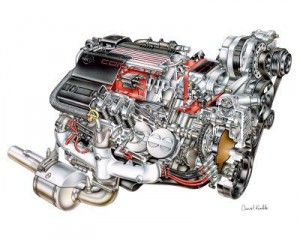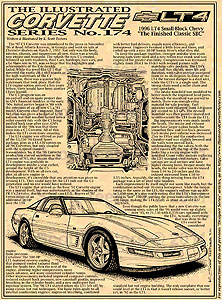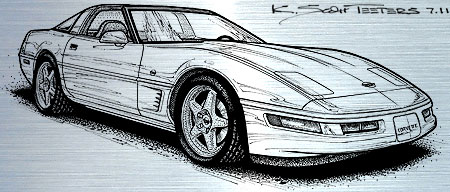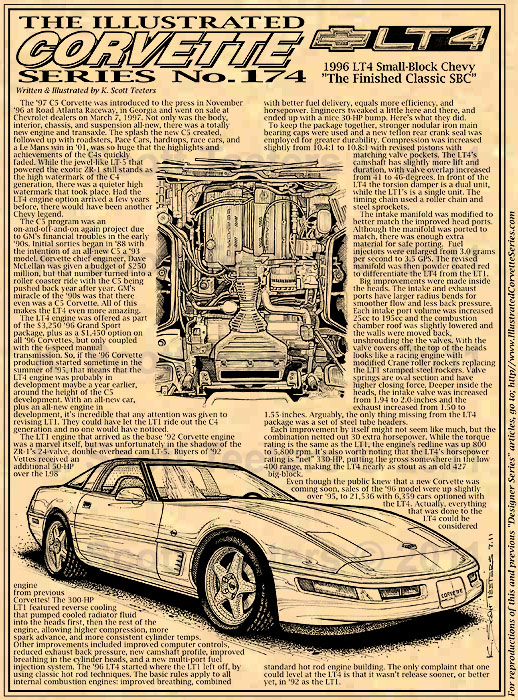Dateline: 9.30.11
Forty One Years of Classic Small-Block Chevy Success and Power!
 When the Cadillac-derived Small-block Chevy engine first arrived in 1955, I’m certain that Ed Cole and his team of Chevrolet engineers never imagined that their efforts would have such a profound and long lasting impact on the automobile industry. The little 265-cubic-inch engine had just 162-horsepower. By 1970 the 350-cubic-inch LT-1 engine was packing 370 gross horsepower. Beginning in 1973 Gm started rating their engines in “net” figures making it look as if the legs had been cut out from under all of their motors. While it’s true that there were emissions restrictions and reduced compression, the “net” power ratings were in real-world terms, closer to reality. From ‘73 to ‘96 it was a long slow slog, but the last SBC to use the basic original design was the 330-horsepower LT4. So, what would be the ”gross” horsepower rating of a ‘96 LT4? That would be anyone’s guess, but somewhere close to or over 400-horsepower would be a good guess.
When the Cadillac-derived Small-block Chevy engine first arrived in 1955, I’m certain that Ed Cole and his team of Chevrolet engineers never imagined that their efforts would have such a profound and long lasting impact on the automobile industry. The little 265-cubic-inch engine had just 162-horsepower. By 1970 the 350-cubic-inch LT-1 engine was packing 370 gross horsepower. Beginning in 1973 Gm started rating their engines in “net” figures making it look as if the legs had been cut out from under all of their motors. While it’s true that there were emissions restrictions and reduced compression, the “net” power ratings were in real-world terms, closer to reality. From ‘73 to ‘96 it was a long slow slog, but the last SBC to use the basic original design was the 330-horsepower LT4. So, what would be the ”gross” horsepower rating of a ‘96 LT4? That would be anyone’s guess, but somewhere close to or over 400-horsepower would be a good guess.
Since Spring ‘11 I have been asking the question in my Illustrated Corvette Series VETTE Magazine column, “What’s the best _____?” for each generation Corvette. ICS No. 174 takes a look at the 1996 LT4 Corvette and asks, is this “The Finished Classic SBC?” let’s get into the details. Talk about going out with a roar! Enjoy – Scott
Illustrated Corvette Series No. 174: 1996 LT4 Small-Block Chevy – “The Finished Classic SBC?”
 The ‘97 C5 Corvette was introduced to the press in November ‘96 at Road Atlanta Raceway, in Georgia and went on sale at Chevrolet dealers on March 7, 1997. Not only was the body, interior, chassis, and suspension all-new, there was a totally new engine and transaxle. The splash the new C5 created, followed up with roadsters, Pace Cars, hardtops, race cars, and a Le Mans win in ‘01, was so huge that the highlights and achievements of the C4s quickly faded. While the jewel-like LT-5 that powered the exotic ZR-1 still stands as the high watermark of the C4 generation, there was a quieter high watermark that took place. Had the LT4 engine option arrived a few years before, there would have been another Chevy legend.
The ‘97 C5 Corvette was introduced to the press in November ‘96 at Road Atlanta Raceway, in Georgia and went on sale at Chevrolet dealers on March 7, 1997. Not only was the body, interior, chassis, and suspension all-new, there was a totally new engine and transaxle. The splash the new C5 created, followed up with roadsters, Pace Cars, hardtops, race cars, and a Le Mans win in ‘01, was so huge that the highlights and achievements of the C4s quickly faded. While the jewel-like LT-5 that powered the exotic ZR-1 still stands as the high watermark of the C4 generation, there was a quieter high watermark that took place. Had the LT4 engine option arrived a few years before, there would have been another Chevy legend.
The C5 program was an on-and-off-and-on again project due to GM’s financial troubles in the early ‘90s. Initial sorties began in ‘88 with the intention of an all-new C5 a ‘93 model. Corvette chief engineer, Dave McLellan was given a budget of $250 million, but that number turned into a roller coaster ride with the C5 being pushed back year after year. GM’s miracle of the ‘90s was that there even was a C5 Corvette. All of this makes the LT4 even more amazing.
The LT4 engine was offered as part of the $3,250 ‘96 Grand Sport package, plus as a $1,450 option on all ‘96 Corvettes, but only coupled with the 6-speed manual transmission. So, if the ‘96 Corvette production started sometime in the summer of ‘95, that means that the LT4 engine was probably in development maybe a year earlier, around the height of the C5 development. With an all-new car, plus an all-new engine in development, it’s incredible that any attention was given to revising LT1. They could have let the LT1 ride out the C4 generation and no one would have noticed.
 The LT1 engine that arrived as the base ‘92 Corvette engine was a marvel itself, but was unfortunately in the shadow of the ZR-1’s 24-valve, double-overhead cam LT-5. Buyers of ‘92 Vettes received an additional 50-HP over the L98 engine from previous Corvettes! The 300-HP LT1 featured reverse cooling that pumped cooled radiator fluid into the heads first, then the rest of the engine, allowing higher compression, more spark advance, and more consistent cylinder temps. Other improvements included improved computer controls, reduced exhaust back pressure, new camshaft profile, improved breathing in the cylinder heads, and a new multi-port fuel injection system. The ‘96 LT4 started where the LT1 left off, by using classic hot rod techniques. The basic rules apply to all internal combustion engines: improved breathing, combined with better fuel delivery, equals more efficiency, and horsepower. Engineers tweaked a little here and there, and ended up with a nice 30-HP bump. Here’s what they did.
The LT1 engine that arrived as the base ‘92 Corvette engine was a marvel itself, but was unfortunately in the shadow of the ZR-1’s 24-valve, double-overhead cam LT-5. Buyers of ‘92 Vettes received an additional 50-HP over the L98 engine from previous Corvettes! The 300-HP LT1 featured reverse cooling that pumped cooled radiator fluid into the heads first, then the rest of the engine, allowing higher compression, more spark advance, and more consistent cylinder temps. Other improvements included improved computer controls, reduced exhaust back pressure, new camshaft profile, improved breathing in the cylinder heads, and a new multi-port fuel injection system. The ‘96 LT4 started where the LT1 left off, by using classic hot rod techniques. The basic rules apply to all internal combustion engines: improved breathing, combined with better fuel delivery, equals more efficiency, and horsepower. Engineers tweaked a little here and there, and ended up with a nice 30-HP bump. Here’s what they did.
 To keep the package together, stronger nodular iron main bearing caps were used and a new teflon rear crank seal was employed for greater durability. Compression was increased slightly from 10.4:1 to 10.8:1 with revised pistons with matching valve pockets. The LT4’s camshaft has slightly more lift and duration, with valve overlap increased from 41 to 46-degrees. In front of the LT4 the torsion damper is a dual unit, while the LT1’s is a single unit. The timing chain used a roller chain and steel sprockets.
To keep the package together, stronger nodular iron main bearing caps were used and a new teflon rear crank seal was employed for greater durability. Compression was increased slightly from 10.4:1 to 10.8:1 with revised pistons with matching valve pockets. The LT4’s camshaft has slightly more lift and duration, with valve overlap increased from 41 to 46-degrees. In front of the LT4 the torsion damper is a dual unit, while the LT1’s is a single unit. The timing chain used a roller chain and steel sprockets.
The intake manifold was modified to better match the improved head ports. Although the manifold was ported to match, there was enough extra material for safe porting. Fuel injectors were enlarged from 3.0 grams per second to 3.5 GPS. The revised manifold was then powder coated red to differentiate the LT4 from the LT1.
 Big improvements were made inside the heads. The intake and exhaust ports have larger radius bends for smoother flow and less back pressure. Each intake port volume was increased 25cc to 195cc and the combustion chamber roof was slightly lowered and the walls were moved back, unshrouding the the valves. With the valve covers off, the top of the heads looks like a racing engine with modified Crane roller rockers replacing the LT1 stamped steel rockers. Valve springs are oval section and have higher closing force. Deeper inside the heads, the intake valve was increased from 1.94 to 2.0-inches and the exhaust increased from 1.50 to 1.55-inches. Arguably, the only thing missing from the LT4 package was a set of steel tube headers.
Big improvements were made inside the heads. The intake and exhaust ports have larger radius bends for smoother flow and less back pressure. Each intake port volume was increased 25cc to 195cc and the combustion chamber roof was slightly lowered and the walls were moved back, unshrouding the the valves. With the valve covers off, the top of the heads looks like a racing engine with modified Crane roller rockers replacing the LT1 stamped steel rockers. Valve springs are oval section and have higher closing force. Deeper inside the heads, the intake valve was increased from 1.94 to 2.0-inches and the exhaust increased from 1.50 to 1.55-inches. Arguably, the only thing missing from the LT4 package was a set of steel tube headers.
Each improvement by itself might not seem like much, but the combination netted out 30 extra horsepower. While the torque rating is the same as the LT1, the engine’s redline was up 800 to 5,800 rpm. It’s also worth noting that the LT4’s horsepower rating is “net” 330-HP, putting the gross somewhere in the low 400 range, making the LT4 nearly as stout as an old 427 big-block.
Even though the public knew that a new Corvette was coming soon, sales of the ‘96 model were up slightly over ‘95, to 21,536 with 6,359 cars optioned with the LT4. Actually, everything that was done to the LT4 could be considered standard hot rod engine building. The only complaint that one could level at the LT4 is that it wasn’t release sooner, or better yet, in ‘92 as the LT1. – Scott

PS – 11 x 17 parchment paper prints of the below image are available HERE.
Here’s the BEST way to keep up with K. Scott Teeters’ Corvette blog!



I recently came across a very nice ’96 Grand Sport that I may be interested purchasing but unfortunatly it is not a numbers matching car. The original LT4 was replaced a couple of years ago by a previous owner, supposedly by a Chevrolet dealer, w a crate LT4 long block but the current owner has no records of the transaction. Except for the obvious (ie. intake manifold) is there any way you know of to ensure the block is really a LT4 & not a LT1. (numbers, marking ,etc) Thanks for any info & help you may have.
Bob
Hi Bob,
Good question. It is my understanding that the LT1 and the LT4 share the same block. It’s nearly everything else inside that’s been enhanced. When researching my story for The Illustrated Corvette Series column, I thought it was pretty neat that what Chevrolet did was essentially build a mildly hot rodded SBC engine with a little extra here and there. There are many small differences that went into gaining 30-hp. An independent builder might have been a little more aggressive and yielded more power. But when the manufacturer builds an engine it has to meet durability standards. Examples being the LT-5 ZR-1 engine in Michael Beal’s that was built by Kim Baker. (Use the search tool in the upper right corner of this site and search for “Michael Beal”) The original LT-5 was rated at 375-HP. Baker easily got 475-HP and told Beal that he built other LT-5 engines that dynoed over 600-hp! The same can be said for the 638-HP LS9 that’s in the C6 ZR1. Lingenfelter Engineering can easily get an extra 100-HP with just bolt-on parts!
So, back to the engine that’s in the 1996 Grand Sport you’re looking at, if you go here… http://www.grandsportregistry.com/lt1vslt4.htm … there’s a side-by-side comparison between the LT1 and the LT4. Most likely, the engine in the car is a real LT4. Another thing you can do is connect with the good folks at http://www.grandsportregistry.com, perhaps that know of some “special external place” on the engine that would verify that it’s really an LT4, besides the red FI unit. Kind’a like looking for the plug fitting on a 427/435 L71 big-block for a dry sump oil system. The 400-HP version with the same 3×2 carb setup and hydraulic lifters doesn’t have the fitting because that engine isn’t intended for racing, but externally the two engines look almost identical.
Hope that helps. If the car is tight, strong, and in good shape, just buy it and don’t sweat the numbers matching issue and do what Zora Arkus-Duntov wanted ALL of his Corvette customers to do with their car… ENJOY IT!
Scott, Thank you for taking the time to help, your thoughts and your good advice. I agree that it is probably a true LT4, and with your info I should be able to check it out. Your best advice however, is to use the car for what it was designed for and to enjoy it. Thanks again Bob
You’re welcome Bob. Besides being Christmas weekend, it’s turning out to be Zora Arkus-Duntov weekend too! Check out today’s post. I’m not sure what he would have thought about customers buying Corvettes and them storing them. Being a “GO! GO! GO! kind’a guy, I think he would have been happiest knowing that his customers redlined their Corvette engines, at least one a day. MINIMUM! Dr. Zora says, “You must redline engine, at least once a day, for the car’s sake, AND your!” If you get the Grand Sport, shoot us some pics! – Scott
Got IT !!! It’s No. 171 (Coupe) Can’t pick it up for about 2 weeks though, it’s out of state, will fly out And drive it back, can’t wait! Will send some pics after I pick it up.
:- ) Bob
Alright Bob! It’s going to be a LONG two weeks! But it’ll be worth it for sure. Congrats! Send us pics when you can.